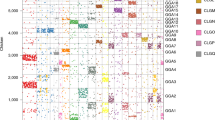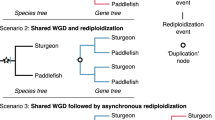Abstract
Opinions on the hypothesis1 that ancient genome duplications contributed to the vertebrate genome range from strong skepticism2,3,4 to strong credence5,6,7. Previous studies concentrated on small numbers of gene families or chromosomal regions that might not have been representative of the whole genome4,5, or used subjective methods to identify paralogous genes and regions5,8. Here we report a systematic and objective analysis of the draft human genome sequence to identify paralogous chromosomal regions (paralogons) formed during chordate evolution and to estimate the ages of duplicate genes. We found that the human genome contains many more paralogons than would be expected by chance. Molecular clock analysis of all protein families in humans that have orthologs in the fly and nematode indicated that a burst of gene duplication activity took place in the period 350–650 Myr ago and that many of the duplicate genes formed at this time are located within paralogons. Our results support the contention that many of the gene families in vertebrates were formed or expanded by large-scale DNA duplications in an early chordate. Considering the incompleteness of the sequence data and the antiquity of the event, the results are compatible with at least one round of polyploidy.
This is a preview of subscription content, access via your institution
Access options
Subscribe to this journal
Receive 12 print issues and online access
$209.00 per year
only $17.42 per issue
Buy this article
- Purchase on Springer Link
- Instant access to full article PDF
Prices may be subject to local taxes which are calculated during checkout



Similar content being viewed by others
References
Ohno, S. Evolution by Gene Duplication (George Allen and Unwin, London, 1970).
Martin, A. Is tetralogy true? Lack of support for the 'one-to-four' rule. Mol. Biol. Evol. 18, 89–93 (2001).
Friedman, R. & Hughes, A.L. Pattern and timing of gene duplication in animal genomes. Genome Res. 11, 1842–1847 (2001).
Hughes, A.L., da Silva, J. & Friedman, R. Ancient genome duplications did not structure the human Hox-bearing chromosomes. Genome Res. 11, 771–780 (2001).
Thornton, J.W. Evolution of vertebrate steroid receptors from an ancestral estrogen receptor by ligand exploitation and serial genome expansions. Proc. Natl Acad. Sci. USA 98, 5671–5676 (2001).
Spring, J. Vertebrate evolution by interspecific hybridisation-are we polyploid? FEBS Lett. 400, 2–8 (1997).
Holland, P.W.H., Garcia-Fernandez, J., Williams, N.A. & Sidow, A. Gene duplications and the origins of vertebrate development. Development Suppl., 125–133 (1994).
Popovici, C., Leveugle, M., Birnbaum, D. & Coulier, F. Coparalogy: physical and functional clusterings in the human genome. Biochem. Biophys. Res. Commun. 288, 362–370 (2001).
International Human Genome Sequencing Consortium. Initial sequencing and analysis of the human genome. Nature 409, 860–921 (2001).
Koh, Y.S. & Moore, D.D. Linkage of the nuclear hormone receptor genes NR1D2, THRB, and RARB: evidence for an ancient, large-scale duplication. Genomics 57, 289–292 (1999).
Smith, N.G.C., Knight, R. & Hurst, L.D. Vertebrate genome evolution: a slow shuffle or a big bang? Bioessays 21, 697–703 (1999).
Venter, J.C. et al. The sequence of the human genome. Science 291, 1304–1351 (2001).
Ruddle, F.H., Bentley, K.L., Murtha, M.T. & Risch, N. Gene loss and gain in the evolution of the vertebrates. Development Suppl., 155–161 (1994).
Flajnik, M.F. & Kasahara, M. Comparative genomics of the MHC: glimpses into the evolution of the adaptive immune system. Immunity 15, 351–362 (2001).
Pébusque, M.-J., Coulier, F., Birnbaum, D. & Pontarotti, P. Ancient large scale genome duplications: phylogenetic and linkage analyses shed light on chordate genome evolution. Mol. Biol. Evol. 15, 1145–1159 (1998).
Kojima, S., Itoh, Y., Matsumoto, S., Masuho, Y. & Seiki, M. Membrane-type 6 matrix metalloproteinase (MT6-MMP, MMP-25) is the second glycosyl-phosphatidyl inositol (GPI)-anchored MMP. FEBS Lett. 480, 142–146 (2000).
Tomsig, J.L. & Creutz, C.E. Biochemical characterization of copine: a ubiquitous Ca2+-dependent, phospholipid-binding protein. Biochemistry 39, 16163–16175 (2000).
Takezaki, N., Rzhetsky, A. & Nei, M. Phylogenetic test of the molecular clock and linearized trees. Mol. Biol. Evol. 12, 823–833 (1995).
Nei, M., Xu, P. & Glazko, G. Estimation of divergence times from multiprotein sequences for a few mammalian species and several distantly related organisms. Proc. Natl Acad. Sci. USA 98, 2497–2502 (2001).
Wang, D.Y., Kumar, S. & Hedges, S.B. Divergence time estimates for the early history of animal phyla and the origin of plants, animals and fungi. Proc. R. Soc. Lond. B 266, 163–171 (1999).
Miyata, T. & Suga, H. Divergence pattern of animal gene families and relationship with the Cambrian explosion. Bioessays 23, 1018–1027 (2001).
Gu, X., Wang, Y. & Gu, J. Age distribution of human gene families showing significant roles of both large- and small-scale duplications in vertebrate evolution. Nature Genet. 31, 205–209 (2002); advance online publication 28 May 2002 (DOI: 10.1038/ng902).
Wolfe, K.H. Yesterday's polyploids and the mystery of diploidization. Nature Reviews Genet. 2, 333–341 (2001).
Makalowski, W. Are we polyploids? A brief history of one hypothesis. Genome Res. 11, 667–670 (2001).
Hughes, A.L. Phylogenetic tests of the hypothesis of block duplication of homologous genes on human chromosomes 6, 9, and 1. Mol. Biol. Evol. 15, 854–870 (1998).
Gu, X. & Huang, W. Testing the parsimony test of genome duplications: a counterexample. Genome Res. 12, 1–2 (2002).
Wolfe, K.H. & Shields, D.C. Molecular evidence for an ancient duplication of the entire yeast genome. Nature 387, 708–713 (1997).
Arabidopsis Genome Initiative. Analysis of the genome sequence of the flowering plant Arabidopsis thaliana. Nature 408, 796–815 (2000).
Notredame, C., Higgins, D.G. & Heringa, J. T-Coffee: a novel method for fast and accurate multiple sequence alignment. J. Mol. Biol. 302, 205–217 (2000).
Gu, X. & Zhang, J. A simple method for estimating the parameter of substitution rate variation among sites. Mol. Biol. Evol. 14, 1106–1113 (1997).
Kumar, S. & Hedges, S.B. A molecular timescale for vertebrate evolution. Nature 392, 917–920 (1998).
Acknowledgements
We thank D.C. Shields, A. Coghlan, A.T. Lloyd and other members of the Wednesday lunch group for discussion. This work was supported by the Health Research Board (Ireland), a Trinity College Dublin High Performance Computing studentship award and Science Foundation Ireland.
Author information
Authors and Affiliations
Corresponding author
Ethics declarations
Competing interests
The authors declare no competing financial interests.
Supplementary information
Rights and permissions
About this article
Cite this article
McLysaght, A., Hokamp, K. & Wolfe, K. Extensive genomic duplication during early chordate evolution. Nat Genet 31, 200–204 (2002). https://doi.org/10.1038/ng884
Received:
Accepted:
Published:
Issue Date:
DOI: https://doi.org/10.1038/ng884
This article is cited by
-
Croizat’s form-making, RNA networks, and biogeography
History and Philosophy of the Life Sciences (2023)
-
Molecular Evolution of Aryl Hydrocarbon Receptor Signaling Pathway Genes
Journal of Molecular Evolution (2023)
-
Fish genomics and its impact on fundamental and applied research of vertebrate biology
Reviews in Fish Biology and Fisheries (2022)
-
Region-specific expression of young small-scale duplications in the human central nervous system
BMC Ecology and Evolution (2021)
-
Artificial whole genome duplication in paleopolyploid sturgeons yields highest documented chromosome number in vertebrates
Scientific Reports (2020)



